Hon Hai Precision Industry Co (鴻海精密), known as Foxconn Technology Group (富士康) outside of Taiwan, on Wednesday announced plans to build a US$10 billion LCD panel plant in Wisconsin, a deal US President Donald Trump said would not have happened without his efforts.
The company said it plans to invest US$10 billion over four years to build a 1.86 million square meter plant that could employ up to 13,000 people.
Trump praised Hon Hai chairman Terry Gou (郭台銘) at a White House event, saying: “If I didn’t get elected, he definitely wouldn’t be spending US$10 billion... This is a great day for America.”
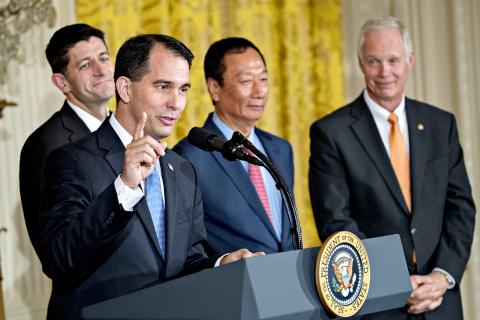
Photo: Bloomberg
Wisconsin Governor Scott Walker said that his state would award US$3 billion in incentives, and was to sign a memorandum of understanding on the investment yesterday.
The state legislature would need to approve the package, he said, adding that about half is for capital costs and nearly half for workforce development. There are also some sales tax exemptions.
The decision “signifies the start of a series of investments by Foxconn in American manufacturing in the coming years,” Hon Hai said in a statement.
The tax incentives would be awarded over 20 years if Hon Hai meets hiring targets, officials said.
The plant would be the largest economic development project in the state’s history, Walker said.
White House Chief of Staff Reince Priebus told a Wisconsin television station that Trump spotted the site of a former Chrysler plant when aboard Marine One over Kenosha, Wisconsin, in April.
When Hon Hai executives met with Trump in the Oval Office, Priebus said: “The president said I know a good spot where you should go — that place in Kenosha.”
Walker said Hon Hai is considering several sites in southeast Wisconsin and is to announce a final site soon.
Wisconsin state Senator Jennifer Shilling questioned whether there is “legislative appetite for a US$1 [billion] to US$3 billion corporate welfare package... The bottom line is this company has a concerning track record of big announcements with little follow-through.”
Meanwhile, Vice Minister of Economic Affairs Yang Wei-fu (楊偉甫) said that the government looks favorably on Hon Hai’s decision to invest in the US, as it demonstrates the business strategy of a multinational corporation like Hon Hai to conduct an effective, global flat-panel operation.
The government hopes that the investment could be a win-win situation for Taiwan and the US in terms of technology and other forms of cooperation, Yang said, adding that the government also hopes the company would consider investing in Taiwan.
The investment would have a limited short-term effect on the development of the local flat-panel industry, given a well-developed domestic supply chain, and resilience and diversification among local manufacturers, the ministry said in a statement.
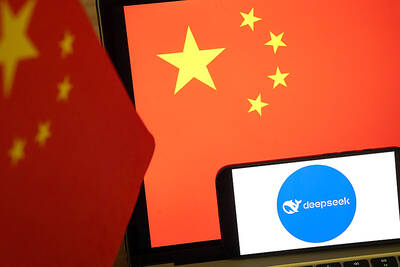
MISINFORMATION: The generated content tends to adopt China’s official stance, such as ‘Taiwan is currently governed by the Chinese central government,’ the NSB said Five China-developed artificial intelligence (AI) language models exhibit cybersecurity risks and content biases, an inspection conducted by the National Security Bureau (NSB) showed. The five AI tools are: DeepSeek, Doubao (豆包), Yiyan (文心一言), Tongyi (通義千問) and Yuanbao (騰訊元寶), the bureau said, advising people to remain vigilant to protect personal data privacy and corporate business secrets. The NSB said it, in accordance with the National Intelligence Services Act (國家情報工作法), has reviewed international cybersecurity reports and intelligence, and coordinated with the Ministry of Justice Investigation Bureau and the National Police Agency’s Criminal Investigation Bureau to conduct an inspection of China-made AI language
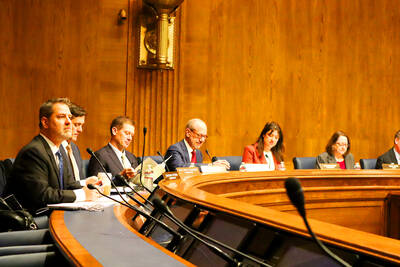
LIMITS: While China increases military pressure on Taiwan and expands its use of cognitive warfare, it is unwilling to target tech supply chains, the report said US and Taiwan military officials have warned that the Chinese People’s Liberation Army (PLA) could implement a blockade within “a matter of hours” and need only “minimal conversion time” prior to an attack on Taiwan, a report released on Tuesday by the US Senate’s China Economic and Security Review Commission said. “While there is no indication that China is planning an imminent attack, the United States and its allies and partners can no longer assume that a Taiwan contingency is a distant possibility for which they would have ample time to prepare,” it said. The commission made the comments in its annual
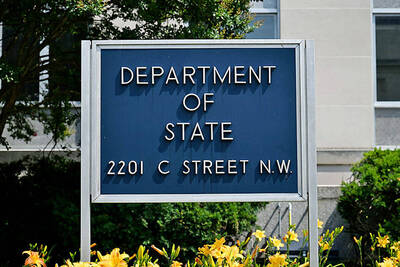
CHECKING BOUNDARIES: China wants to disrupt solidarity among democracies and test their red lines, but it is instead pushing nations to become more united, an expert said The US Department of State on Friday expressed deep concern over a Chinese public security agency’s investigation into Legislator Puma Shen (沈伯洋) for “secession.” “China’s actions threaten free speech and erode norms that have underpinned the cross-strait ‘status quo’ for decades,” a US Department of State spokesperson said. The Chongqing Municipal Public Security Bureau late last month listed Shen as “wanted” and launched an investigation into alleged “secession-related” criminal activities, including his founding of the Kuma Academy, a civil defense organization that prepares people for an invasion by China. The spokesperson said that the US was “deeply concerned” about the bureau investigating Shen
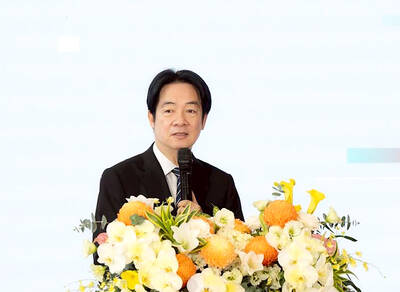
‘TROUBLEMAKER’: Most countries believe that it is China — rather than Taiwan — that is undermining regional peace and stability with its coercive tactics, the president said China should restrain itself and refrain from being a troublemaker that sabotages peace and stability in the Indo-Pacific region, President William Lai (賴清德) said yesterday. Lai made the remarks after China Coast Guard vessels sailed into disputed waters off the Senkaku Islands — known as the Diaoyutai Islands (釣魚台) in Taiwan — following a remark Japanese Prime Minister Sanae Takaichi made regarding Taiwan. Takaichi during a parliamentary session on Nov. 7 said that a “Taiwan contingency” involving a Chinese naval blockade could qualify as a “survival-threatening situation” for Japan, and trigger Tokyo’s deployment of its military for defense. Asked about the escalating tensions